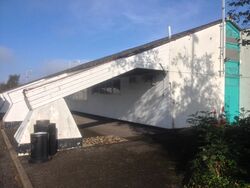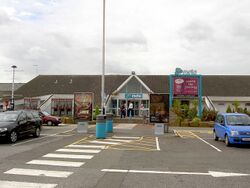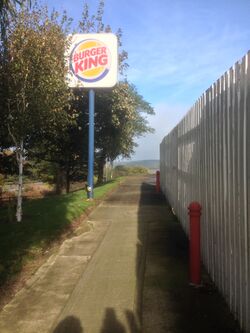History of Woolley Edge services

The disused transport café, with the roof extending to the ground.

In the 1960s motorway service areas had proven to be a big hit with operators and the public, but Woolley Edge was the first sign that things were going to change.
Design and Contract
See also: M1 Service Area Planning
The formulas required that a service area be built near here, but the traffic levels were forecast to be low. Woolley Edge was the most suitable site available, but it still had unstable coal seams running beneath it and a tunnel ventilation shaft to contend with.
As a result, no footbridge was be permitted between the two facilities, as it would be too difficult to build. Applicants were told connections to the local road network would be too difficult too. These factors made the site even less attractive.
Bids
Interested developers were invited to submit their applications to build Woolley Edge in 1966, but nobody replied. This was the system's first failure, and there was a feeling of hopelessness and that all interest had been lost.
A developer needed to be found, so the Ministry spun the disaster into an opportunity, opening a new round of bids that would be more geared towards oil companies, rather than caterers. Controversially, applicants only needed to sell one brand of fuel. They were also allowed to use temporary buildings for the first 10 years, and a minimum spend of £90,000 per side was requested.
The new contract was split into two, with bids being registered separately for the northbound and southbound side.
It was suggested a snack building be built, possibly with its own entrance, as many people here would want snacks only. Due to the complications with the land, a suggested layout was provided.
Shell were rumoured to be interested but didn't bid.
Blue Boar
Blue Boar bid to run the southbound service area only. Their financial offer was poor, their building design and catering arrangements were "well conceived", but the layout differed so vastly from the advice given that they were eventually ruled out.
They would have provided a two-storey amenity building with the restaurant on top, with toilets, a shop and the kitchen underneath. The entrance would have been at mezzanine level. Seating would have been provided for 308 people.
A self-service transport café would have been provided.
Taverna

Taverna submitted bids for both the north- and the southbound service area. Their financial offer for the southbound side was excellent, however this was dependent on their not-as-good offer for the northbound side being approved. Taverna appeared to share other operators' views that the southbound side would be more profitable.
For each side, there were vending machines and an AA kiosk at the entrance. Inside took you to a large foyer. Against the wall on the left were vending machines, with toilets and the shop at the back. The main café would have joined the foyer.
The building structure was kept light because of the issues with the land. It was designed by Challen, Floyd & Partners. The walls were grey brick with cedar shingles covering the roof, described by inspectors as "undesirable".
The dining area was criticised for its poor view, and the building was described as "self-conscious" and "fussy". Taverna had promised to trial more experimental automated catering arrangements here, furnished with hardwood seating with plastic tables.
On the northbound side, a separate entrance to the transport café was provided at the back, while the southbound side had the café in a separate building. The transport café would have had walls covered with ceramic tiles.
Seating would have been provided for 702 people, with 84 toilets, 465 car parking spaces, 109 lorry bays and 12 coach bays. Space was left at the back of each amenity building for an extension.
Opening and Operation

Inspectors were concerned about Taverna's strategic bid, as they reckoned the northbound side was worth more than they were offering. However, realising that a third round of bids may not yield any better results, they accepted Taverna's offer for both sides of the service area, subject to the building being reconsidered.
The roof of the building was changed to extend to the ground, which was described as "spectacular" when it opened. This was created on the basis that the building would need to stand out during any snowdrifts. The timber cladding design is supposed to look discreet and enclosed, but it was described as too assertive for such an attractive site.
The service area was the first to go for a more rural design that could not be seen from the road, a theme which was continued inside.
A temporary connection to the local road network which had been used to build the motorway was adopted to become a Rear Access.
Granada
When Granada took over, they painted the building bright red and white.
The service area continued to suffer from low traffic levels, which made providing satisfactory facilities difficult. In 1974 they admitted the site was a disappointment, and blamed it on traffic heading towards Newcastle being directed off the M1 at J32. By the 1980s, the transport cafés had closed and HGV drivers were directed to the main restaurant. There were also issues with the southbound restaurant closing at night, and some customers reporting they were told to make the long walk across Bramley Lane.
The Huddersfield Daily Examiner said it had "the atmosphere of a food clinic" when they visited in November 1977.
The service area was unfortunately implicated in the search for Peter Sutcliffe in 1980. He told police he had disposed of evidence there.
Granada were given permission to change Woolley Edge's name to "Wakefield" in June 1996. The proposal was abandoned due to the cost and poor reaction, although the new name was used in some of their publicity.
Each building had an appendage added to it to house a Burger King. In 2000, the southbound service area was identified as having the potential to benefit from a significant investment, providing one of Granada's new-look shopping areas. This saw a short corridor added to the front of the amenity building, causing it to clearly stick out from the otherwise rectangular building.
Since then, additional facilities, especially the arrival of M&S Simply Food in 2007, have brought additional trade to the service area.
In early 2017, the northbound EDC restaurant closed and a Greggs replaced it.